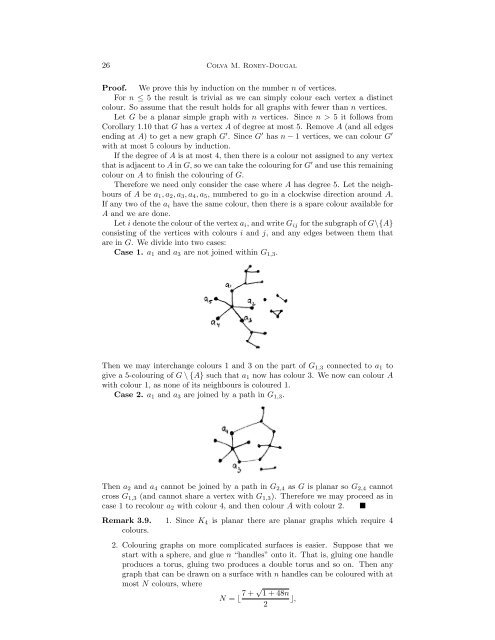Create successful ePaper yourself
Turn your PDF publications into a flip-book with our unique Google optimized e-Paper software.
26 Colva M. Roney-DougalProof. We prove this by induction on the number n of vertices.For n ≤ 5 the result is trivial as we can simply colour each vertex a distinctcolour. So assume that the result holds for all graphs with fewer than n vertices.Let G be a planar simple graph with n vertices. Since n > 5 it follows fromCorollary 1.10 that G has a vertex A of degree at most 5. Remove A (and all edgesending at A) to get a new graph G ′ . Since G ′ has n − 1 vertices, we can colour G ′with at most 5 colours by induction.If the degree of A is at most 4, then there is a colour not assigned to any vertexthat is adjacent to A in G, so we can take the colouring for G ′ and use this remainingcolour on A to finish the colouring of G.Therefore we need only consider the case where A has degree 5. Let the neighboursof A be a 1 , a 2 , a 3 , a 4 , a 5 , numbered to go in a clockwise direction around A.If any two of the a i have the same colour, then there is a spare colour available forA and we are done.Let i denote the colour of the vertex a i , and write G ij for the subgraph of G\{A}consisting of the vertices with colours i and j, and any edges between them thatare in G. We divide into two cases:Case 1. a 1 and a 3 are not joined within G 1,3 .Then we may interchange colours 1 and 3 on the part of G 1,3 connected to a 1 togive a 5-colouring of G \ {A} such that a 1 now has colour 3. We now can colour Awith colour 1, as none of its neighbours is coloured 1.Case 2. a 1 and a 3 are joined by a path in G 1,3 .Then a 2 and a 4 cannot be joined by a path in G 2,4 as G is planar so G 2,4 cannotcross G 1,3 (and cannot share a vertex with G 1,3 ). Therefore we may proceed as incase 1 to recolour a 2 with colour 4, and then colour A with colour 2. Remark 3.9. 1. Since K 4 is planar there are planar graphs which require 4colours.2. Colouring graphs on more complicated surfaces is easier. Suppose that westart with a sphere, and glue n “handles” onto it. That is, gluing one handleproduces a torus, gluing two produces a double torus and so on. Then anygraph that can be drawn on a surface with n handles can be coloured with atmost N colours, whereN = ⌊ 7 + √ 1 + 48n⌋,2













